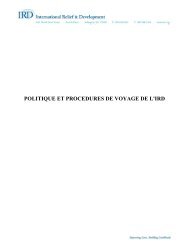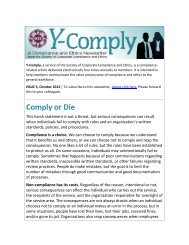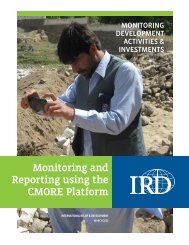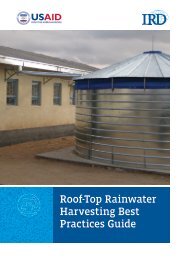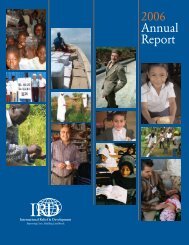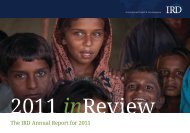Empowering citizens Engaging governments Rebuilding communities
Empowering citizens Engaging governments Rebuilding communities
Empowering citizens Engaging governments Rebuilding communities
Create successful ePaper yourself
Turn your PDF publications into a flip-book with our unique Google optimized e-Paper software.
most important, <strong>citizens</strong> were impressed.<br />
A sizable number of Iraqis, regardless<br />
of whether they were directly involved in<br />
the program, credit CSP with improving<br />
security and government services<br />
in reducing sectarian strife. Therefore, CSP’s youth<br />
activities component aimed for something more personal<br />
than jobs—it aimed to help young Iraqis connect<br />
to their identity, culture, and community and to give<br />
them enhanced opportunities to form social bonds<br />
that would be stronger than the pull of the insurgency.<br />
Altogether, IRD’s youth activities engaged more than<br />
350,000 participants through soccer matches and<br />
tournaments and a wide range of other activities.<br />
A legacy of positive perceptions<br />
IRD staff, from field workers to leadership, exude<br />
pride when talking about CSP, but the program had<br />
many other fans as well. Former Deputy Secretary of<br />
State Jacob Lew said CSP was considered “one of<br />
the most effective counterinsurgency efforts in Iraq.”<br />
Arizona Senator John McCain, Connecticut Senator<br />
Joe Lieberman, General Petraeus, and others made<br />
visits to CSP project sites firsthand. And Ryan Crocker,<br />
during his 2007–09 tenure as the US ambassador<br />
to Iraq, repeatedly lauded CSP’s track record of job<br />
creation. “I’ve had discussions with the [Iraqi] government,”<br />
Crocker said in late 2007, midway through<br />
CSP’s implementation. “What they want, they want<br />
jobs. They want something that looks like a stable<br />
future. . . . They’re saying, ‘I want gainful employment.’<br />
And we know how to do this because we’ve done it<br />
with community stabilization.”<br />
Perhaps most important, Iraqi <strong>citizens</strong> were<br />
impressed. At the program’s conclusion, evaluators<br />
worked with two independent Iraqi polling companies<br />
to survey almost 1,400 CSP participants and nonparticipants<br />
about the perceived effectiveness of CSP<br />
activities, how well community needs were addressed,<br />
and the local support for those activities. While<br />
economic and security variables make it impossible<br />
to establish direct causality between CSP activities<br />
and a reduction in violence, the poll results show that<br />
a sizable number of Iraqis, regardless of whether they<br />
were directly involved in the program, credit CSP with<br />
improving security and government services:<br />
• 84 percent of CSP-type program participants said<br />
their community was safer in 2009 than in 2006<br />
because of CSP, an assessment shared by 70<br />
percent of nonparticipants.<br />
• 69 percent of program participants said CSP<br />
helped improve government services.<br />
• 60 percent of participants credited CSP with<br />
bettering relations between religious and ethnic<br />
groups.<br />
According to USAID’s Jeanne Pryor, the results showed<br />
that “It worked. All four components worked. Polling<br />
data, in addition to the outputs that had been measured,<br />
reported that beneficiaries did notice a positive<br />
impact in their community.”<br />
* * *<br />
This report revisits IRD’s work in Iraq from the beginning<br />
of ICAP in 2003 to the close of CSP in 2009.<br />
It is not a project performance assessment but an<br />
examination of the approach and the results, informed<br />
primarily by the people who carried it out. In considering<br />
the impact of ICAP and CSP, it’s important to<br />
consider factors in addition to outcomes and indicators,<br />
to grasp the weight of individual moments that<br />
made up the collective whole. These observations<br />
are important, because they put a human face on the<br />
anonymous “beneficiary” and the generic “staffer.”<br />
For an endeavor like CSP, heavily debated and controversial,<br />
they also offer a complete way of seeing the<br />
program—its accomplishments, its shortcomings,<br />
and, more importantly, its lasting impact.<br />
5



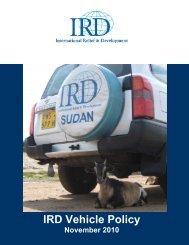
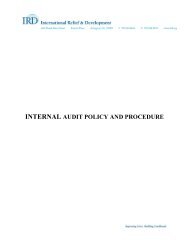
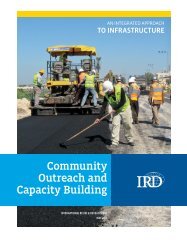
![Guide bonne pratique production d'oignon qualité_VF_4_2411012[1]](https://img.yumpu.com/23506639/1/184x260/guide-bonne-pratique-production-doignon-qualitac-vf-4-24110121.jpg?quality=85)
